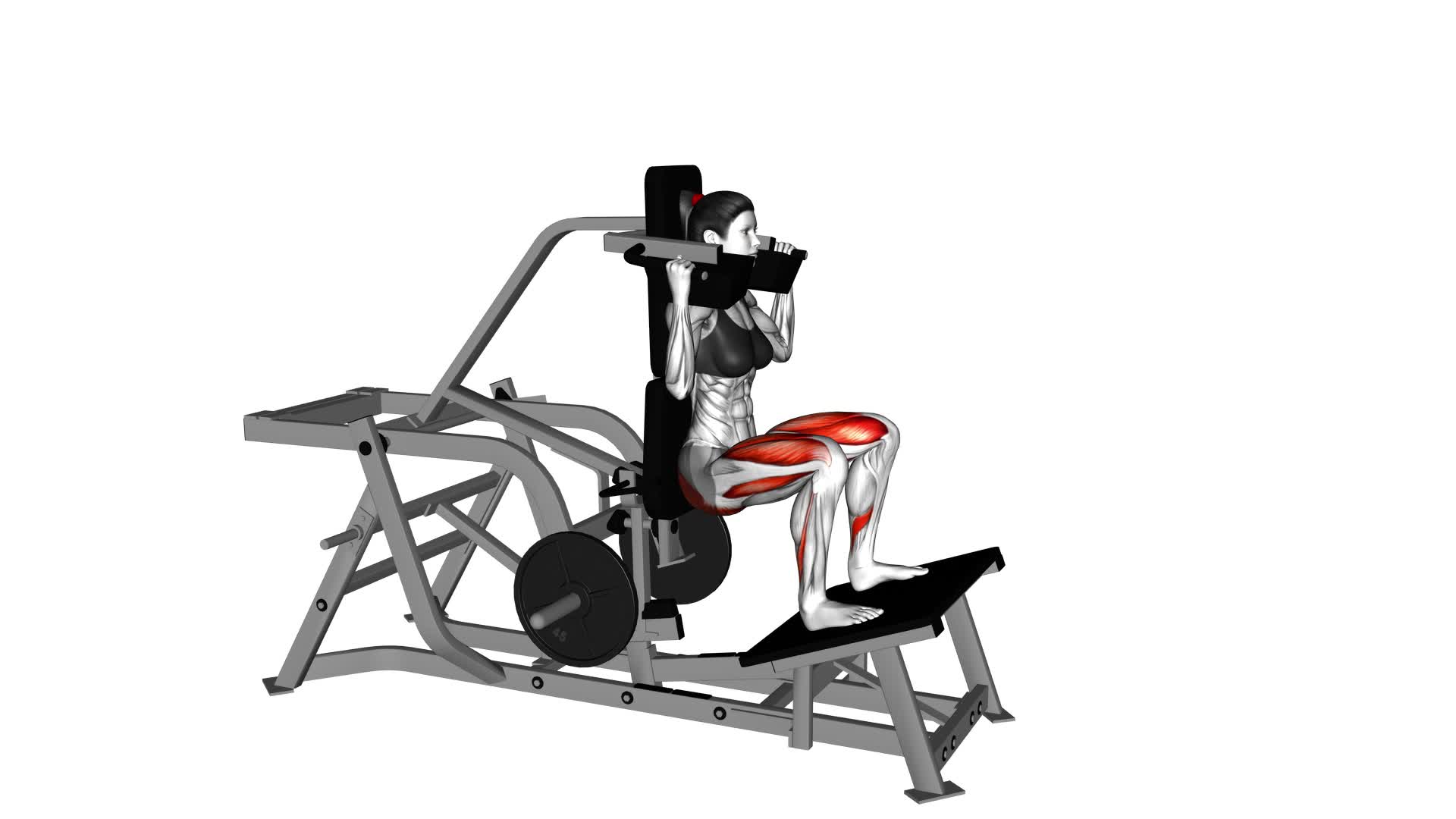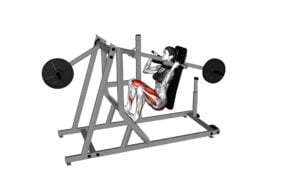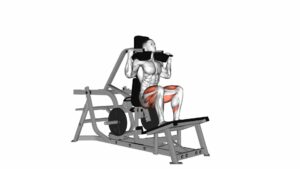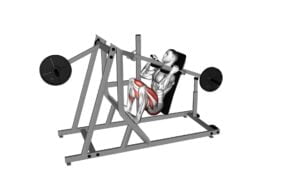Lever Squat (Plate Loaded) (Female) – Video Exercise Guide & Tips

Are you a female looking to level up your squat game? Look no further than the lever squat (plate loaded).
Watch This Exercise Video
In this video exercise guide, you'll find all the tips and techniques you need to master this effective lower body exercise. Whether you're a beginner or an experienced fitness enthusiast, there are variations and modifications for every fitness level.
Avoid common mistakes and discover tips for increasing intensity and progression. Get ready to squat like a pro!
Key Takeaways
- Lever squat can increase strength in lower body muscles such as quadriceps, glutes, and hamstrings.
- Lever squat can improve muscle tone in the lower body.
- Lever squat can enhance overall fitness, stability, balance, and coordination.
- Lever squat provides a targeted approach for greater strength gains compared to traditional squat.
Benefits of Lever Squat for Females
The lever squat offers numerous benefits for females, including increased strength, improved muscle tone, and enhanced overall fitness. When comparing the lever squat to the traditional squat for females, it becomes evident that the lever squat provides unique advantages.
One of the key benefits of the lever squat is its ability to improve lower body strength in women. By utilizing a plate-loaded lever machine, the lever squat allows for a controlled range of motion, targeting specific muscles in the lower body such as the quadriceps, glutes, and hamstrings. This targeted approach can lead to greater strength gains compared to the traditional squat, which relies on bodyweight or external weights.
In addition to increasing strength, the lever squat can also help women improve muscle tone in their lower body. The controlled movement of the lever squat allows for proper activation of the targeted muscles, leading to increased muscle recruitment and development. This can result in more defined and sculpted legs and glutes.
Furthermore, the lever squat contributes to enhanced overall fitness for females. By engaging multiple muscle groups and promoting proper form and technique, the lever squat not only strengthens the lower body but also improves stability, balance, and coordination. These factors are crucial for everyday activities and sports performance.
Proper form and technique are essential when performing the lever squat to maximize its benefits and prevent injuries.
Proper Form and Technique
To perform the lever squat with proper form and technique, you should always maintain a consistent and controlled range of motion. Here are some key tips to help you execute this exercise correctly:
- Keep your feet shoulder-width apart and your toes pointed slightly outward.
- Engage your core and maintain a neutral spine throughout the movement.
- As you descend into the squat, focus on sitting back and down, as if you were sitting into a chair.
- Keep your knees in line with your toes and avoid letting them collapse inward.
- Push through your heels as you rise back up to the starting position.
Now, let's address some common misconceptions about the lever squat. One misconception is that this exercise is only for advanced lifters. In reality, anyone can benefit from incorporating the lever squat into their workout routine, as long as they start with lighter weights and focus on proper form.
As for equipment needed, the lever squat requires a plate-loaded lever squat machine, which can be found in most gyms.
With a solid understanding of proper form and technique, you can now explore variations and modifications for all fitness levels.
Variations and Modifications for All Fitness Levels
You can modify the lever squat to suit your fitness level. If you're a beginner, it's important to start with lighter weights and focus on mastering the proper form and technique. Gradually increase the weight as you become more comfortable and confident. Additionally, you can perform the lever squat using a resistance band instead of a barbell to reduce the load and make it more manageable.
For those who are more advanced, there are several variations of the lever squat that you can incorporate into your workout routine. One option is to perform the exercise with one leg at a time, which increases the intensity and challenges your stability and balance. Another variation is the jump squat, where you explosively jump up from the squat position, engaging your leg muscles even more.
To further challenge yourself, you can add weight to the exercise by using a weighted vest or holding dumbbells in your hands while performing the squat. This will increase the resistance and help you build strength and muscle.
Remember to always listen to your body and adjust the lever squat according to your fitness level. Whether you're a beginner or advanced, there are modifications and variations available to help you progress and reach your fitness goals.
Common Mistakes to Avoid
Avoid making these common mistakes when performing the lever squat to ensure proper form and maximize your workout results. Here are some tips for improvement:
- Rounding your back: Keep your back straight throughout the movement to prevent injury and maintain proper alignment.
- Not going low enough: Make sure to squat deep enough so that your thighs are parallel to the ground. This ensures that you're engaging your leg muscles fully.
- Using too much weight: Start with a manageable weight and gradually increase it as you get stronger. Using too much weight can compromise your form and increase the risk of injury.
- Leaning forward: Maintain an upright posture throughout the squat. Leaning forward puts excessive stress on your lower back and can lead to strain.
- Neglecting proper breathing: Remember to breathe in as you lower yourself down and exhale as you push back up. Proper breathing helps to stabilize your core and provide energy for the movement.
By avoiding these common mistakes, you'll be able to perform the lever squat with proper form and maximize the benefits of this exercise.
Now, let's move on to the next section to learn some tips for increasing intensity and progression in your lever squat routine.
Tips for Increasing Intensity and Progression
To increase the intensity and progression of your lever squat routine, focus on incorporating challenging variations and gradually increasing the weight load. By adding variations to your lever squats, such as single-leg squats or squat jumps, you can target different muscle groups and engage your core even more. These advanced techniques not only increase the challenge but also help to prevent plateaus in your fitness journey.
Another way to intensify your lever squat routine is by gradually increasing the weight load. Start with a weight that challenges you, but still allows you to maintain proper form. As you become more comfortable and stronger, gradually increase the weight to continue challenging your muscles and promoting growth. However, it's important to note that safety should always be a priority. Only increase the weight load if you can maintain proper form without compromising your safety.
Remember to listen to your body and progress at a pace that's comfortable for you. Pushing yourself too hard too soon can lead to injuries and setbacks. Increase the weight load and incorporate advanced techniques gradually, allowing your body to adapt and grow stronger over time.
With consistency and patience, you'll see progress and achieve your fitness goals.
Frequently Asked Questions
Can Lever Squats Help in Improving Posture?
Lever squats are a great exercise for improving your posture. By incorporating lever squats into your workout routine, you can strengthen your core and back muscles, which are essential for maintaining proper alignment.
Unlike traditional squats, lever squats provide additional stability and support, making them ideal for individuals with postural imbalances or injuries.
Are Lever Squats Only Beneficial for Lower Body Muscles?
Lever squats aren't only beneficial for lower body muscles. They offer a range of variations that target different muscle groups, helping to improve overall strength and stability.
By incorporating lever squats into your workout routine, you can engage your core, glutes, and upper body as well. These exercises are an effective way to develop functional strength and enhance posture.
How Many Sets and Repetitions Should Be Performed During a Lever Squat Workout?
When performing a lever squat workout, it's important to consider the number of sets and repetitions to maximize its benefits. The number of sets and reps can vary depending on your fitness goals and experience level.
To build strength and muscle, aim for 3-4 sets of 8-12 reps.
If you're looking to improve endurance, go for higher reps and lower weight.
Can Lever Squats Be Performed by Individuals With Knee or Back Injuries?
Lever squats can be modified for individuals with knee or back injuries. These modifications help reduce strain on the affected areas while still providing the benefits of the exercise. Incorporating lever squats into a rehabilitation program can improve strength, stability, and range of motion.
Are Lever Squats Suitable for Beginners or Individuals With Limited Fitness Experience?
Lever squats can be a great exercise for beginners or those with limited fitness experience. They provide a stable and controlled movement, making them safer for individuals who may not have the strength or stability for traditional squats.
Lever squat modifications can also be used to tailor the exercise to your specific needs or limitations.
Additionally, lever squats offer benefits for athletes, such as improved lower body strength and power, which can enhance performance in sports and other physical activities.
Conclusion
In conclusion, the lever squat is a highly effective exercise for females of all fitness levels. By maintaining proper form and technique, individuals can reap the benefits of this exercise, such as strengthening the lower body and improving overall stability.
It's important to avoid common mistakes and gradually increase intensity for progression. Incorporating variations and modifications can also help cater to different fitness levels.
With these tips in mind, females can confidently incorporate the lever squat into their workout routine.

Author
Years ago, the spark of my life’s passion ignited in my mind the moment I stepped into the local gym for the first time. The inaugural bead of perspiration, the initial endeavor, the very first surge of endorphins, and a sense of pride that washed over me post-workout marked the beginning of my deep-seated interest in strength sports, fitness, and sports nutrition. This very curiosity blossomed rapidly into a profound fascination, propelling me to earn a Master’s degree in Physical Education from the Academy of Physical Education in Krakow, followed by a Sports Manager diploma from the Jagiellonian University. My journey of growth led me to gain more specialized qualifications, such as being a certified personal trainer with a focus on sports dietetics, a lifeguard, and an instructor for wellness and corrective gymnastics. Theoretical knowledge paired seamlessly with practical experience, reinforcing my belief that the transformation of individuals under my guidance was also a reflection of my personal growth. This belief holds true even today. Each day, I strive to push the boundaries and explore new realms. These realms gently elevate me to greater heights. The unique combination of passion for my field and the continuous quest for growth fuels my drive to break new ground.







